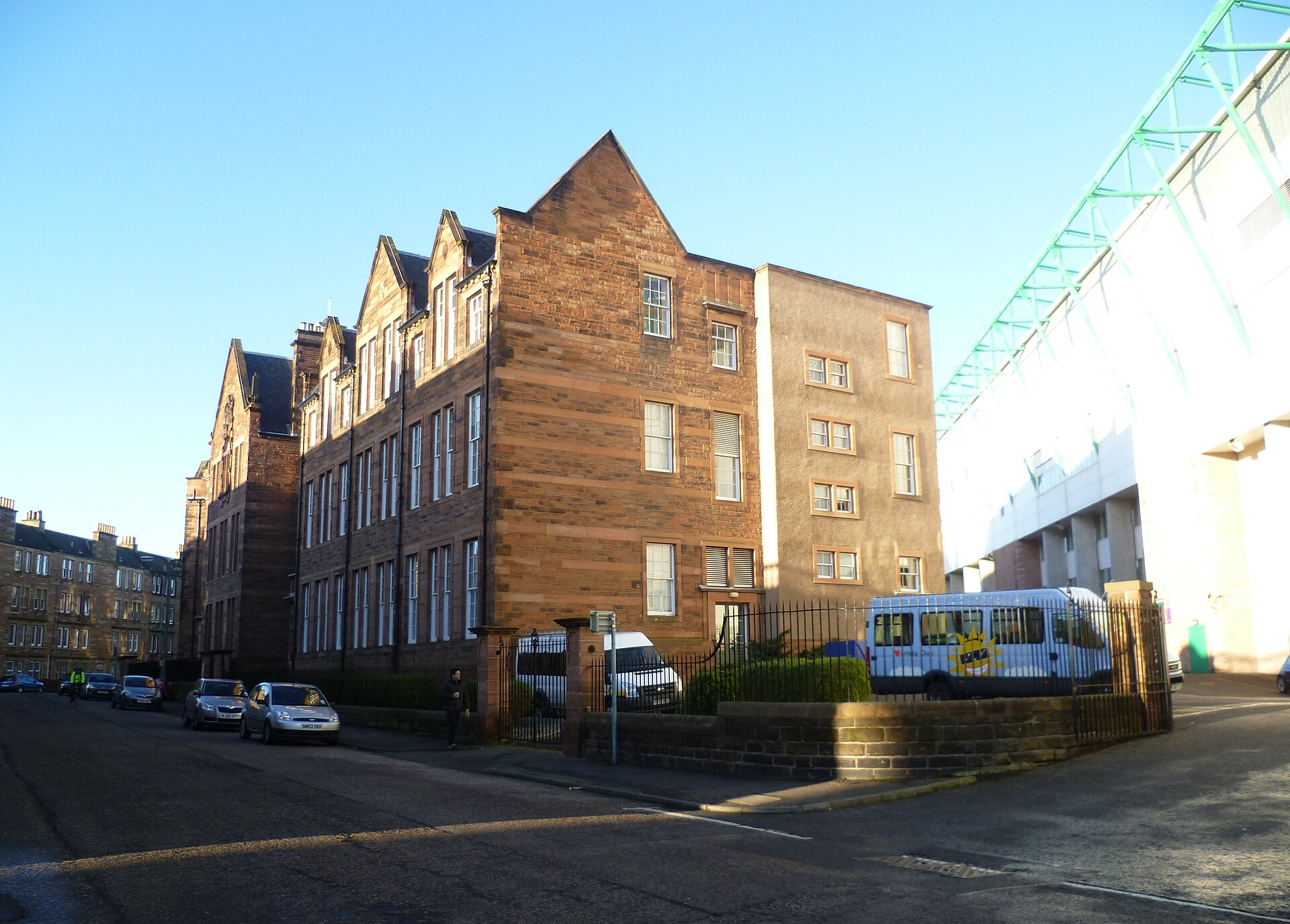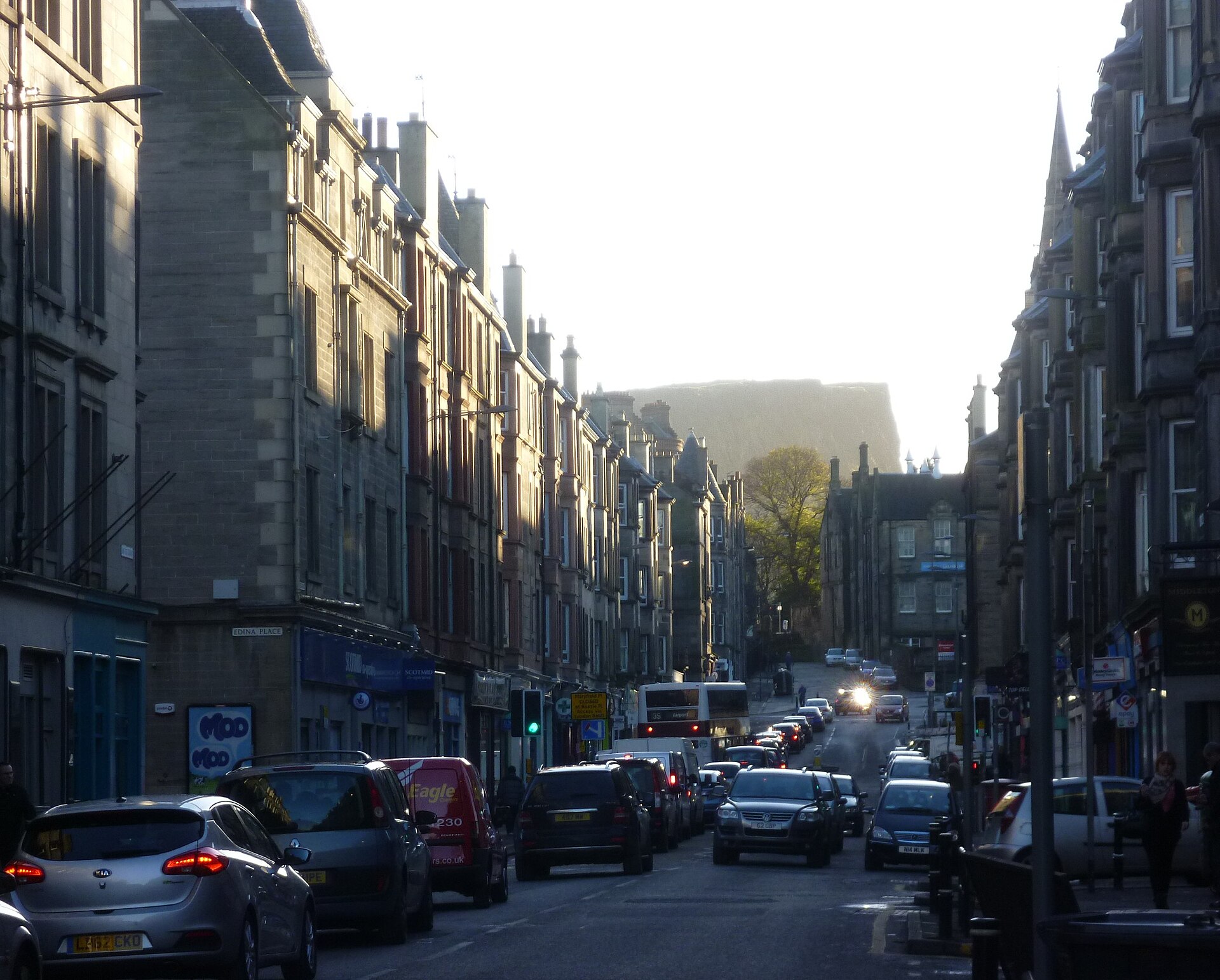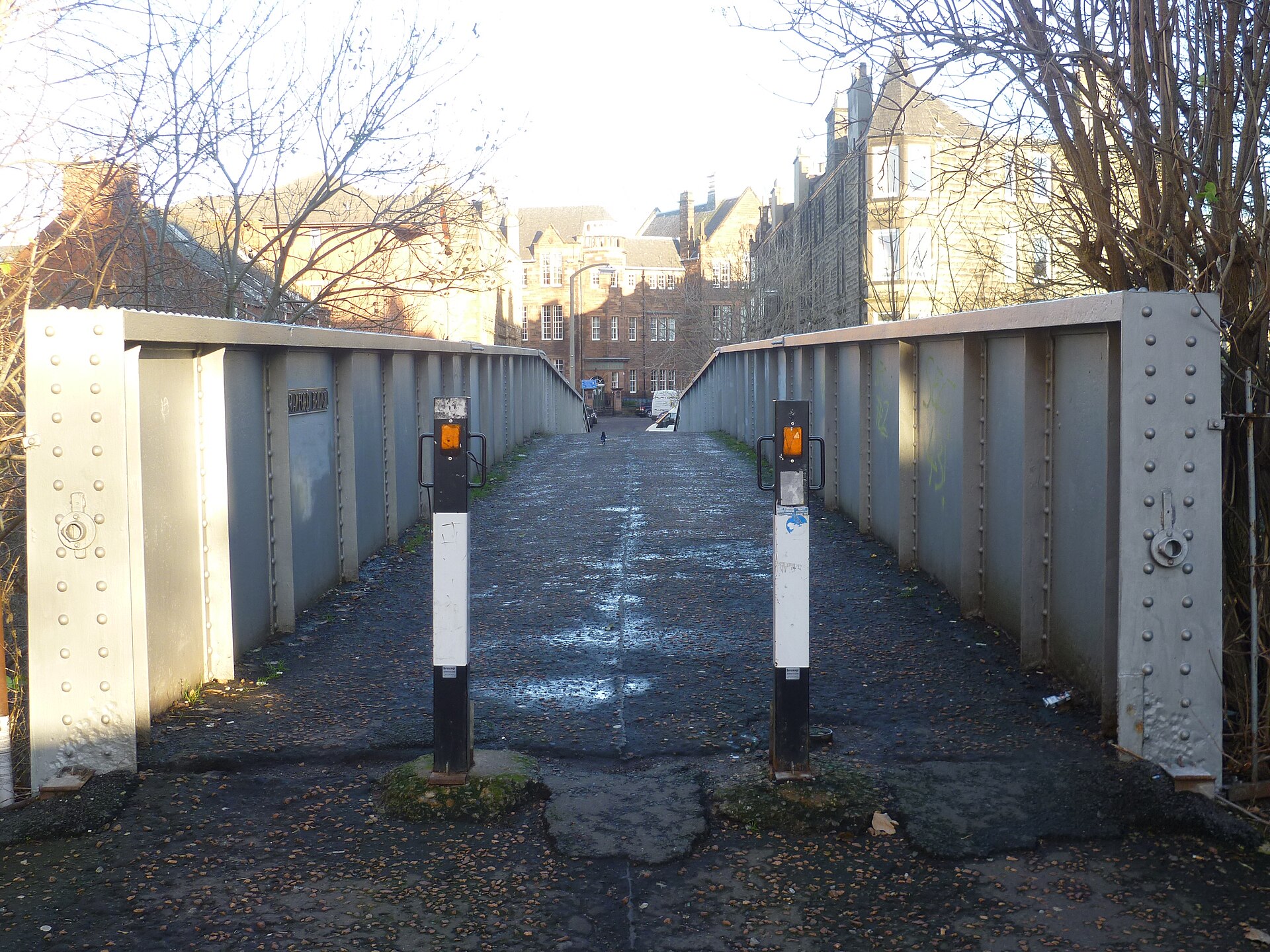
ザ・シンギング・ストリート
The Singing Street

☆ 「ザ・シングング・ストリート」は、1950年にスコットランドのエディンバラで制作された短編映画で、1951年に初めて上映された。ノートン・パー ク・スクール」の教師グループが制作したもので、生徒たちが伝統的な子供向けの歌を歌いながら街中でストリートゲームに興じる様子を撮影した。この映画 は、制作から数十年の間にほとんど消滅してしまった口承の伝統を記録したものだ。
☆The film can be viewed on the Scottish Screen Archive website.
| "The Singing Street",
is a short film made in 1950 in Edinburgh, Scotland and first shown in
1951. It was created by a group of teachers from Norton Park School,
who filmed some of their pupils playing street games, accompanied by
traditional children's songs, at various locations in the city. It
documented an oral tradition which has all but vanished in the decades
since it was made. |
「ザ・
シングング・ストリート」は、1950年にスコットランドのエディンバラで制作された短編映画で、1951年に初めて上映された。ノートン・パーク・ス
クール」の教師グループが制作したもので、生徒たちが伝統的な子供向けの歌を歌いながら街中でストリートゲームに興じる様子を撮影した。この映画は、制作
から数十年の間にほとんど消滅してしまった口承の伝統を記録したものだ。 |
Norton Park School Norton Park School beside Easter Road football stadium Norton Park was an inner-city Junior Secondary School (equivalent to a Secondary Modern School in England at the time). The old burgh boundary between Edinburgh and Leith runs through the school grounds. The building still stands beside the Easter Road football stadium of Hibernian F.C. but is now a business conference centre. At the time of filming the area was a more industrial environment than now with numerous industrial premises including two major printing works, a large engineering works, a timber merchant's yard and a tobacco factory surrounded by tenement buildings built chiefly for artisans in the second half of the nineteenth century. The songs were collected by James T.R. Ritchie, a science teacher at the school, assisted by his colleagues Nigel McIsaac and Raymond Townsend, both art teachers. McIsaac produced rough storyboard sketches and calculated timings to provide the shooting script. The camera was operated by William Geissler and Townsend. The songs were recorded subsequently, with no re-takes necessary, and 'dubbed' onto the film. According to the film's production notes, the Scottish poet Norman McCaig supplied the whistling heard on the soundtrack.[1] The 'Norton Park Group' then shot, cut and edited the film themselves, while taking advice from the Scottish Film Council, the British Film Institute and Campbell Harper Films.[2] |
ノートン・パーク・スクール イースター・ロード・フットボール・スタジアムに隣接するノートン・パーク・スクール ノートン・パークは、市街地にあるジュニア・セカンダリー・スクール(当時、英国におけるセカンダリー・モダン・スクールに相当)であった。エディンバラ とリースを隔てる古い市境が、この学校の敷地を貫いている。この建物は、現在もハイバーニアンFCのイースター・ロード・フットボール・スタジアムの隣に 建っているが、現在はビジネス会議センターとして使用されている。撮影当時、この地域は現在よりも工業地帯としての色彩が強く、2つの主要印刷工場、大規 模なエンジニアリング工場、木材商の倉庫、19世紀後半に主に職人のために建てられた長屋に囲まれたタバコ工場など、多数の工業施設があった。 歌は、同校の理科教師ジェームズ・T・R・リッチーが収集し、美術教師の同僚ナイジェル・マカイザックとレイモンド・タウンゼントが手伝った。マカイザッ クはラフな絵コンテを描き、撮影用の台本を作成するためにタイミングを計算した。撮影はウィリアム・ガイスラーとタウンゼントが担当した。歌はその後録音 され、再録音は必要なく、フィルムに「ダビング」された。映画の制作ノートによると、サウンドトラックで聞こえる口笛はスコットランドの詩人ノーマン・ マッケイグが提供したものである。[1] その後、「ノートン・パーク・グループ」がスコットランド映画協議会、英国映画協会、キャンベル・ハーパー・フィルムズの助言を受けながら、撮影、編集、 編集を行った。[2] |
 The densely populated Easter Road area of Edinburgh The film was shot in monochrome and lasts 18 minutes. Its stated purpose was "to show how the singing games are played – in their natural setting. Beginning in the morning and ending with the dusk…"[2] The cast comprised around 60 pupils, aged between 11 and 14 years of age. Shooting took place on six days during the school Easter holiday break in 1950 in local locations including streets and backgreens (communal drying areas) off Easter Road, and streets around the Calton Hill and in the Canongate, West Bow and the Grassmarket. The Shore, Leith appears briefly at the end of the film. Most of the games revolve around the themes of love and death (courtship and bereavement), expressed in rhymes passed down the generations by word of mouth. Notes accompanying the issue of the film on video in 1993 explain that "The rhymes…vary from street to street and change from day to day. (…) What is old seldom dies yet there is always something new appearing. The word is accepted and the poetry is kept alive. No one asks: What does that mean?".[2] The songs in the film are accompanied by various skipping and ball games. The film is subtitled A Merry-Ma Tanzie which is a traditional Scottish wedding game sung to the same tune as Here we go round the Mulberry Bush. Girls join hands in a circle and, at a chosen point, fall to the ground. One player, usually chosen for her slowness in falling, leaves the circle and confides the name of the one she intends to marry to a close friend. The circle members sing verses to guess his name and, on approval, the girl and her friend, as a bridal couple, are welcomed into the circle through "high arches" and kiss. The first recorded mention of the game occurs in Blackwood's Magazine published in Edinburgh in August 1821.[3] In one variation girls form a circle with a player in the middle covering her face while the circle moves slowly round her. The circle sing verses with the girl's name and try to guess her suitor's name. If her true love is revealed, the girl has to show her face and choose a partner. The circle then opens as a gate to allow the bridal couple to pass through. In the variation shown in the film (The Golden City) friends of the girl inside the circle quickly confide with each other to determine her intended sweetheart and name him in the song. She then chooses a partner from the circle in his place to form the bridal couple. |
 人口密度の高いエディンバラのイースターロード地区 この映画はモノクロで撮影され、18分間の長さである。その目的は「歌合戦が自然な環境の中でどのように行われるかを紹介すること」とされている。朝から始まり夕暮れで終わる...」[2] 出演者は11歳から14歳までの約60人の生徒たちであった。撮影は1950年のイースター休暇中の6日間、イースター・ロードの周辺にある通りや裏庭 (共同乾燥場)、カルトン・ヒル周辺の通り、キャノンゲート、ウェスト・ボウ、グラスマーケットなど、地元の場所で行われた。映画の最後に、リースにある ザ・ショアが少しだけ映し出される。 ゲームのほとんどは、口頭で世代から世代へと伝えられた韻文で表現される愛と死(求愛と死別)をテーマとしている。1993年にビデオで発売された際の解 説によると、「韻文は…通りごとに異なり、日々変化する。(中略)古いものは滅びることが少ないが、常に新しいものが現れる。言葉は受け入れられ、詩は生 き続けている。誰もこうは問わない。どういう意味?」と問う者はいない。[2] 映画で歌われる歌は、さまざまなスキップやボール遊びに合わせて歌われる。 この映画の字幕は『A Merry-Ma Tanzie』で、これは『Here we go round the Mulberry Bush』と同じメロディで歌われるスコットランドの伝統的な結婚式のゲームである。少女たちは輪になって手をつなぎ、合図とともに地面に倒れこむ。通 常、倒れ方が遅かった者が選ばれ、輪から離れ、親しい友人に結婚する相手の名前を打ち明ける。輪のメンバーはその名前を当てようと節を歌い、正解が出る と、その少女とその友人は花嫁花婿として「高いアーチ」を通って輪の中へ迎え入れられ、キスをする。このゲームについて最初に記録された言及は、1821 年8月にエディンバラで発行された『ブラックウッド・マガジン』に掲載されている。[3] あるバリエーションでは、少女たちが輪になり、その真ん中に座った少女が顔を隠す。輪になった少女たちがゆっくりと彼女の周りを回る。輪になった少女たち が、彼女の名前を歌いながら、彼女の婚約者の名前を当てようとする。もし彼女の真の愛が明らかになった場合、少女は顔を見せ、パートナーを選ぶことにな る。その後、輪は門のように開き、花嫁と花婿が通り抜ける。映画『黄金の都』で紹介されているバリエーションでは、輪の中の少女の友人が互いに打ち明け合 い、彼女の意中の人を特定し、歌の中でその人の名前を呼ぶ。そして、少女は輪の中からその人の代わりとなる相手を選び、花嫁と花婿となる。 |
 The Crawford Bridge (named after a city councillor) is a footbridge over a now rarely used railway line. It appears several times in the first half of the film. It points directly to Norton Park School which can be seen in the distance. The film captured a slice of children's history shortly before playing in the street began to decline with the advent of mass television ownership in Britain, though games seen in the film continued to be played in school playgrounds throughout the 1950s and into the 1960s. The 1950s were a time when the Edinburgh Corporation (town council) had designated many inner-city streets "children's play areas", requesting vehicle drivers to avoid them from the end of the school day until sunset.[4] Also, as James Ritchie pointed out in the decade after the film, slum clearance soon transformed the surroundings in which most children grew up: "The tenement-factory conglomeration produced by accident a playing environment of exciting variety: and unless present-day architecture incorporates such ideas, it's dead from the start. The houses in modern schemes are so dull and unmysterious. They have no 'Unknown Corners' such as haunted painters like James Pryde..."[5] The film received praise when it was shown at the UNICA Festival in Barcelona Film Festival in 1952.[1] John Grierson, "father of the documentary", wrote that it was "the best amateur film I ever saw... The reason for it being wonderful was quite simple. Somebody loved something and conveyed it."[6] James Ritchie later wrote two short books about children's songs, The Singing Street (1964)[7] and Golden City (1965). In the latter he described how his interest in the children's games had been first aroused, One morning in Norton Park School, I was teaching science in Leith [the part of the school inside Leith's boundary], and finding the response on this occasion not very lively, I asked, "Then what do you like doing?" The class answered: "We like playing games." "What games?" They told me, and I began then and there to write them down. In the afternoon whilst teaching mathematics in Edinburgh [the part of the school inside Edinburgh's boundary], I also found time to jot down some more games. From then on I collected every sort of rhyme or playing jingle, and my collection grew."[8] The US folk-song collector Alan Lomax made audio recordings of the Norton Park pupils during the first of his three field trips to Scotland in 1951, 1953 and 1957. These can be heard on the still widely available CD entitled Singing in the Streets: Scottish Children’s Songs. Lomax was a major inspiration behind the founding of the School of Scottish Studies at Edinburgh University in the same year the film was first shown.[9] One scene, where a group of boys are singing on a flight of steps, features an onlooker wearing a hat and gloves and holding a walking stick. This is Pat Murray, an Edinburgh Councillor. As an avid collector of children's toys, he was the prime mover behind the creation of Edinburgh's Museum of Childhood which opened in 1955 and is now a major tourist attraction housed on the city's Royal Mile. [1] |
 クロフォード橋(市の議員の名前に由来)は、現在ではほとんど使われなくなった線路にかかる歩道橋である。映画の前半で何度か登場する。遠くにノートン・パーク・スクールが見える。 この映画は、イギリスでテレビが一般家庭に普及し始め、子供たちが外で遊ぶことが減り始める直前の子供たちの歴史の一端を捉えている。ただし、映画の中で 見られる遊びは、1950年代から1960年代にかけて、学校の校庭で引き続き行われていた。1950年代には、エディンバラ市議会(市議会)が市街地の 多くの通りを「子供の遊び場」に指定し、学校が終わる時間から日没まで、車の運転手にその区域を避けるよう要請していた。[4] また、映画公開後の10年間で、ジェームズ・リッチーが指摘したように、スラム街の撤廃により、ほとんどの子供たちが育つ環境はすぐに変化した。「偶然に 生まれた長屋と工場の集合体は、実にバラエティに富んだ遊び場を生み出した。そして、現代の建築がそのようなアイデアを取り入れない限り、それは最初から 死んでいる。現代の集合住宅はあまりにも退屈で、ミステリアスさに欠ける。ジェームズ・プライドのような幽霊が出そうな長屋のような『未知のコーナー』が ないのだ...」[5] この映画は、1952年のバルセロナ映画祭のUNICAフェスティバルで上映された際に高い評価を受けた。[1] 「ドキュメンタリーの父」と呼ばれるジョン・グリアソンは、「私がこれまでに見たアマチュア映画の中で最高のものだ。素晴らしい理由は極めて単純だ。誰か が何かを愛し、それを伝えたのだ」と記している。[6] ジェームズ・リッチーはその後、子供たちの歌について2冊の短い著書、『ザ・シング・ストリート』(1964年)[7]と『ゴールデン・シティ』(1965年)を書いた。後者では、子供たちの遊びに対する関心が最初に芽生えた経緯について次のように述べている。 ある朝、ノートン・パーク・スクールで、私はリース(学校の境界線内にあるリース地区)で科学を教えていた。その時の反応はあまり活発ではなかったので、 「じゃあ、何をするのが好き?」と尋ねた。すると、生徒たちは「ゲームをするのが好き」と答えた。「どんなゲーム?」と尋ねると、彼らは教えてくれたの で、私はその場で書き留めることにした。午後、エディンバラ(エディンバラの境界内にある学校の一部)で数学を教えている間にも、私はさらにいくつかの ゲームを書き留める時間を見つけた。それ以来、私はあらゆる種類の韻や遊びのジングルを集め、私のコレクションは増えていった。 米国のフォークソング収集家アラン・ロマックスは、1951年、1953年、1957年の3回にわたってスコットランドを訪れた際、最初の訪問時にノート ン・パークの子供たちの音声を録音した。この音声は、現在でも広く入手可能なCD『Singing in the Streets: Scottish Children’s Songs』で聞くことができる。ロマックスは、映画が初めて上映されたのと同じ年に、エディンバラ大学スコットランド研究学部(School of Scottish Studies)の創設に大きな影響を与えた人物である。 少年たちが階段で歌っている場面では、帽子と手袋を身につけ、ステッキを持った見物人が登場する。この人物はエディンバラ市議会議員のパット・マレー氏で ある。子供のおもちゃの熱心な収集家であったマレー氏は、1955年に開館したエディンバラ子供博物館の創設の立役者でもあり、この博物館は現在ではロイ ヤル・マイルに位置する主要な観光名所となっている。[1] |
| The featured songs 1. The Golden City 2. Weary, weary, waiting on you 3. Down to the baker's shop 4. Sweet Jenny 5. On the Mountain 6. The Bluebird 7. Bluebells and dummie shells 8. O alla tinka 9. Little sandy girl 10. Three Jews from Spain 11. The bonny bunch of roses 12. The Dusting Bluebells 13. The Golden City 14. When I was single 15. Up and down 16. Plainie, clappie 17. I Sent Her For Butter 18. Down in the valley 19. Orphan girl 20. The night was dark 21. I once had a boy 22. Broken-hearted I wandered |
特集曲 1. ゴールデン・シティ 2. Weary, weary, waiting on you 3. Down to the baker's shop 4. スウィート・ジェニー 5. On the Mountain 6. ブルーバード 7. ブルーベルとダミーシェル 8. O alla tinka 9. リトル・サンド・ガール 10. スペインからの3人のユダヤ人 11. 愛らしいバラの束 12. ブルーベルの粉吹き 13. 黄金郷 14. 独身だった頃 15. アップ・アンド・ダウン 16. 平野、カエル 17. バターを買いに 18. 谷底 19. 孤児の少女 20. 夜は暗かった 21. かつて少年がいた 22. 傷心でさまよい |
| Film content summary 00.08 - pan of Edinburgh Old Town from Princes Street (possibly from first-level platform of the Scott Monument) 00.56 - tilt view of Crawford Bridge and Albion Terrace with the Calton Hill in the distance from Norton Park School 01.06 - Title: The Singing Street chalked on wall 01.17 - girl calls from street to open tenement window (probably Albion Terrace); two girls double-skipping past a St. Cuthbert's Co-operative milk cart in Albion Road; girl reflected in shop window singing to herself; girls double-skipping 02.03 - two girls with third skipping in Albion Terrace 02.17 - girls skipping with Crawford Bridge in background 02.23 - girl playing with diabolo 02.27 pedestrians in Leith Street 02.32 - girls playing ring game on road setts 02.58 - girls skipping in Bothwell Street with Crawford Bridge behind 03.15 - girls in ring game at end of Bothwell Street with Crawford Bridge on left 03.36 - junction of Calton Road and Leith Street 03.39 - girl in ring behind Bothwell Street tenement with locomotive steam behind 03.51 - aerial view of two girls crossing Crawford Bridge from Albion Terrace to Bothwell Street 04.15 - girls playing next to timber yard behind Bothwell Street tenement 05.04 - pan up from Bothwell Street to Salisbury Crags 05.10 - pan down from Salisbury Crags to girls skipping in St. John Street with Holyrood Road behind (Moray House teacher training college on the left) 05.31 - girls on steps (unidentified location, possibly off Leith Street) 06.20 - follow-my-leader ring game in Norton Park School playground 07.10 - junction of Calton Road and Leith Street 07.16 - Abbey Mount: view from London Road Gardens of a No.1 bus crossing the junction with a "steamie" (municipal laundry) in background 07.36 - girls in ring game, Royal Terrace, Calton Hill 07.46 - The Golden City rhyme chalked on pavement 08.48 - girls skipping along Royal Terrace past Greenside Church towards Leith Walk 09.25 - pedestrians and traffic at the top of Leith Street 09.33 - three girls skipping in Calton Road below the Regent Arch 10.10 - view of Calton Road looking towards Leith Street from the Regent Arch 10.17 - girl "stottin' a ba' off a wa' " in one of the Abbeyhill "rows"; boys playing "bools" (marbles)—"Come on, away ye go! This is a lassies' den!"—girl playing "peevers" (hopscotch); boys singing (probably steps in Alva Place); another girl bouncing a ball off a wall 12.01 - bird’s-eye view of West Norton Place from Regent Road School; girls double-rope skipping with tram in London Road passing top of Easter Road; slow-motion skipping sequence; girl roller-skating 12.42 - top of Victoria Street from George IV Bridge; girls playing hide-and-seek on Victoria Terrace and the Upper Bow Steps; group of girls on Victoria Terrace with India Buildings behind; Bowfoot rooftops 13.49 - girls skipping at gates of the Eastern Cemetery, Drum Place; angels drawn in chalk on pavement 14.13 - unidentified rooftops; girl skipping in street with coal merchant’s lorry behind (unidentified location) 14.45 - top of Victoria Street (showing steel frame construction of the National Library of Scotland, erected in 1939 but completed only after the war, 1950–55); girls skipping down Victoria Terrace and Victoria Street, left and right; Margaret 'Peggy' McGillivray on street turns curve of the Bowfoot; girls wave farewell; Bowfoot rooftops; Peggy continues down towards the Grassmarket, but emerges at Sandport Place Bridge on The Shore, Leith. References |
映画の内容のまとめ 00.08 - スコット記念塔の1階のプラットフォームから撮影したと思われる、プリンス・ストリートから見たエディンバラ・オールド・タウンの全景 00.56 - ノートン・パーク・スクールからカルトン・ヒルを遠景に捉えた、クロフォード橋とアルビオン・テラスの傾斜ビュー 01.06 - タイトル:壁にチョークで描かれた「歌うストリート」 01.17 - 通りから長屋の窓を開け放つように呼びかける少女(おそらくアルビオン・テラス); アルビオン・ロードの聖カスバート協同組合の牛乳配達車前をダブルスキップする2人の少女; 自分に向かって歌いながら店の窓に映る少女; ダブルスキップする少女たち 02.03 - アルビオン・テラスで3人目の少女とダブルスキップする2人の少女 02.17 - 背景にクロフォード橋を配してダブルスキップする少女たち 02.23 - ディアボロで遊ぶ少女 02.27 - リース・ストリートを行く歩行者 02.32 - 道路で縄跳びをする少女たち 02.58 - ボスウェル・ストリートで縄跳びをする少女たち。背後にクロフォード・ブリッジ 03.15 - ボスウェル・ストリートの突き当たりで縄跳びをする少女たち。左にクロフォード・ブリッジ 03.36 - カルトン・ロードとリース・ストリートの交差点 03.39 - ボスウェル・ストリートの集合住宅の裏手の輪の中で、機関車の蒸気に向かって立つ少女 03.51 - アルバニア・テラスからボスウェル・ストリートに向かってクロフォード橋を渡る2人の少女の空撮 04.15 - ボスウェル・ストリートの集合住宅の裏手の木材置き場の隣で遊ぶ少女たち 05.04 - ボスウェル・ストリートからサルズベリー・クラッグスに向かってパン 05.10 - サルズベリー・クラッグスからパンダウン、ホリールード・ロードを背にセント・ジョン・ストリートでスキップする少女たち(左にモレー・ハウス教員養成大学 05.31 - 階段の少女たち(場所不明、おそらくリース・ストリート付近 06.20 - ノートン・パーク・スクール校庭での「フォロー・マイ・リーダー」の輪遊び 07.10 - カルトン・ロードとリース・ストリートの交差点 07.16 - アビー・マウント:ロンドン・ロード・ガーデンズから見た、交差点を横断する1番バスと背景の「スチームイー」(市営洗濯場) 07.36 - ロイヤル・テラス、カルトン・ヒルで輪になって遊ぶ少女たち 07.46 - 舗道にチョークで書かれた「ゴールデン・シティ」の韻文 08.48 - ロイヤル・テラス沿いをグリーンスイド教会の前を通ってリース・ウォーク方面へスキップする少女たち 09.25 - リース・ストリートの上り口の歩行者と交通 09.33 - リージェント・アーチの下のカルトン・ロードで縄跳びをする3人の少女 10.10 - リージェント・アーチからリース・ストリート方面を望むカルトン・ロードの眺め 10.17 - アビーヒルの「縄跳び」で縄跳びをする少女。「ボーリング」で遊ぶ少年たち(ビー玉)。「さあ、行こう!ここは女の子の場所だ!」。「ピーバーズ」(石蹴 り)で遊ぶ少女。少年たちが歌っている(おそらくアルヴァ・プレイスのステップ)。壁にボールを弾ませる別の少女。 12.01 - リージェント・ロード・スクールからウェスト・ノートン・プレイスを俯瞰した様子。イースター・ロードの頂上を通過するロンドン・ロードの路面電車を背景に、2本の縄跳びをする少女たち。スローモーションで縄跳びをする様子。ローラースケートをする少女 12.42 - ジョージ4世橋からビクトリア・ストリートを俯瞰した様子。ビクトリア・テラスとアッパー・ボウ階段でかくれんぼをする少女たち。ビクトリア・テラスに集まる少女たち。背後にインディア・ビルディングが見える。ボウフットの屋根 13.49 - ドラム・プレイスのイースタン墓地の門の前で縄跳びをする少女たち、歩道にチョークで描かれた天使たち 14.13 - 不明の屋根;石炭商のトラックを背に道で縄跳びをする少女(撮影地不明 14.45 - ビクトリア・ストリートの上部(1939年に建設が開始されたものの、戦後1950年から1955年になってようやく完成したスコットランド国立図書館の 鉄骨構造が見える);ビクトリア・テラスとビクトリア・ストリートで縄跳びをする少女たち 、左と右に曲がるマーガレット・マクギリヴレイがボウフットのカーブを曲がる。少女たちが手を振って別れを告げる。ボウフットの屋根。ペギーはグラスマー ケットに向かって歩き続けるが、リースのザ・ショアにあるサンドポートプレイス橋に出る。 参考文献 |
| 1. "Full record for The Singing Street". Scottish Screen Archive. Retrieved 1 December 2012. 2. City of Edinburgh Museums and Galleries video booklet, Albyn Press, 1993 3. I and P Opie, The Singing Game, OUP 1985, pp.148 and 152; Many theories exist as to the origin of the name, but the Opies give prominence to the following. "In 1868 an observer in Glasgow was certain the words were 'And round about Mary matan'sy'; and remarked on the way children bent to the ground when they repeated them, in the way children did in Antwerp when playing a similar game, to the same tune, with the figure of the Madonna in the centre. The line might therefore, he suggested, mean 'Round about Mary our matins say', and certainly children at this time moved round slowly, rather than briskly, and curtsied to the ground rather than fell to the ground, the one who last regained her position being the one who was required to say her sweetheart's name." If that supposition is correct, it is evidence of the game's origins in Scotland's pre-Reformation Catholic past. 4. One of the official "children's play area" street signs off Easter Road can be seen at Edinphoto 5. Ritchie, J (1999). Golden City (reprint ed.). Edinburgh: Mercat Press. p. 2. ISBN 1873644-973. 6. Ritchie, J (1999). Golden City (reprint ed.). Edinburgh: Mercat Press. p. viii. ISBN 1873644-973. 7. Ritchie, J (2000). The Singing Street: Scottish Children's Games Rhymes & Sayings (reprint ed.). Edinburgh: Mercat. ISBN 1841830135. 8. Ritchie, J (1999). Golden City (reprint ed.). Edinburgh: Mercat Press. p. ix. ISBN 1873644-973. 9. See article, Alan Lomax: Gatherer of Songs |
1. 「ザ・シング・ストリート」全記録。スコットランド・スクリーン・アーカイブ。2012年12月1日取得。 2. エディンバラ市博物館・美術館ビデオブックレット、Albyn Press、1993年 3. I and P Opie著『The Singing Game』OUP 1985年、148ページおよび152ページ。この名称の由来については多くの説があるが、Opie夫妻は次のような説を重視している。「1868年、グ ラスゴーの観察者は、その歌詞が『And round about Mary matan'sy』であると確信し、子供たちがそれを繰り返す際に地面に身をかがめる様子について、アントワープの子供たちが同様の遊びをする際に、同じ 歌を歌いながらマドンナの絵を真ん中に置いて行う様子と似ていると指摘した。したがって、この歌詞は「マリアの周りを回って私たちは朝の祈りを唱える」と いう意味ではないかと彼は示唆した。確かにこの頃の子供たちは、活発にではなくゆっくりと動き回り、地面にひざまずくのではなく地面に礼をした。最後に元 の体勢に戻った者が、恋人の名前を言うように求められた。」もしこの仮説が正しければ、この遊びがスコットランドの宗教改革前のカトリックの時代に起源を 持つという証拠となる。 4. イースター・ロードの公式「子供用プレイエリア」道路標識の1つはEdinphotoで確認できる 5. Ritchie, J (1999). Golden City (reprint ed.). Edinburgh: Mercat Press. p. 2. ISBN 1873644-973. 6. Ritchie, J (1999). Golden City (reprint ed.). Edinburgh: Mercat Press. p. viii. ISBN 1873644-973. 7. Ritchie, J (2000). The Singing Street: Scottish Children's Games Rhymes & Sayings (reprint ed.). Edinburgh: Mercat. ISBN 1841830135. 8. Ritchie, J (1999). Golden City (reprint ed.). Edinburgh: Mercat Press. p. ix. ISBN 1873644-973. 9. 記事「アラン・ロマックス:歌の収集家」を参照 |
| https://en.wikipedia.org/wiki/The_Singing_Street |
|
| The film can be viewed on the Scottish Screen Archive website. |
|
リ ンク
文 献
そ の他の情報
cc
Copyleft, CC, Mitzub'ixi Quq Chi'j, 1996-2099
☆
 ☆
☆